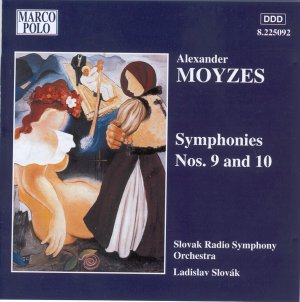As the years passed Moyzes' symphonies became increasingly
querulous, diaphanous in texture and probing. He became more the Pierrot
- in serenade, in enchantment or in rebellion. The Tenth bucks the trend
but the trend is still there.
With his Ninth Symphony Moyzes was far distant
from heavily-laden Mahlerian orchestration. If Mahlerian at all he favoured
the delicate soloistic lace of Das Lied's Abschied rather
than anything else. Shostakovich (who died in 1975 between the completion
of Moyzes' two symphonies) must also have been an influence. There is
some uproariously exultant horn and trombone work in the Allegro
con brio and the blazing final 4 minutes grips in much the same
way as the clamour of William Schuman and Robert Simpson. The solo violin
rears up in the third movement as it does in the first; there are only
three. That solo violin calls out in sorrowing disillusion before the
final rushing crescendo; and in that solo I discern the true culmination
of the symphony. Surely that crescendo was only added for politically
compliant purposes.
The Tenth is in four movements and seems to
dissect and reassemble tributary streams from Brahms, Beethoven, Kodaly
(Galanta and Peacock) and Bartok (Concerto for Orchestra).
It could easily have been dubbed the Classical. A lovely, vibrato-less
(in this case) solo for the French Horn marks out the Larghetto
(III). This solo is placed in parallel with the horn solo in Tchaikovsky
5 but it does not have the thematically long span of the Tchaikovsky.
The work is attractive but has an indeterminate or, I should say, elusive
profile.
The piano pizzicato at 1.10 in the andante
[II] of the Ninth displays the fine recording qualities of the Concert
Hall of Slovak Radio which I have already praised in reviews of the
other parts of this integral collection.
The Ninth was premiered on 26 September 1971 by Zdenek
Kosler conducting the Slovak PO. The Tenth on 3 May 1979 with the present
conductor directing the Slovak PO. Both premieres took place in Bratislava.
Two symphonies in the disillusioned and cynical tradition
the roots for which were struck by Kurt Weill in his two symphonies
here further inflamed by accelerants from Shostakovich and Debussy.
Essential notes again from Ivan Marton.
This is the fifth issue in the uniform Marco Polo series
of the twelve Moyzes symphonies. Going by the many days spent in the
studio these are no mere run-throughs but statements of faith and conviction.
Rob Barnett
NOTE
Earlier issues in this series. Each has been reviewed
for this site:-
Alexander MOYZES Symphonies 1 and 2 Marco Polo
8.225088
Alexander MOYZES Symphonies 3 and 4 Marco Polo 8.225089
Alexander MOYZES Symphonies 5 and 6 Marco Polo 8.225090
Alexander MOYZES Symphonies 7 and 8 Marco Polo 8.225091


